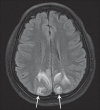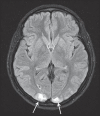Cortical visual loss in posterior reversible encephalopathy syndrome in late postpartum eclampsia: case series
- PMID: 24881617
- PMCID: PMC4065522
- DOI: 10.4103/0301-4738.133525
Cortical visual loss in posterior reversible encephalopathy syndrome in late postpartum eclampsia: case series
Abstract
The purpose of this study was to determine the prevalence of visual disturbances in patients with posterior reversible encephalopathy syndrome (PRES) associated with late postpartum eclampsia. We retrospectively reviewed the clinical records of late postpartum eclampsia patients with features of PRES for the presence of visual disturbances and location of radiological abnormalities. We found a higher prevalence of cortical visual loss in patients with PRES associated with late postpartum eclampsia. Bilateral symmetrical vasogenic edema of the parieto-occipital lobe was the most common magnetic resonance imaging (MRI) abnormality noted. No significant differences were observed in the extent of edema in patients with and without visual loss.
Conflict of interest statement
Figures


Similar articles
-
Posterior reversible encephalopathy syndrome (PRES) in a patient with late postpartum eclampsia.BMJ Case Rep. 2014 Feb 27;2014:bcr2013203162. doi: 10.1136/bcr-2013-203162. BMJ Case Rep. 2014. PMID: 24577180 Free PMC article.
-
Acute cortical blindness caused by pre-eclampsia in the antepartum; posterior reversible encephalopathy syndrome (PRES).Afr Health Sci. 2015 Jun;15(2):705-8. doi: 10.4314/ahs.v15i2.51. Afr Health Sci. 2015. PMID: 26124823 Free PMC article. No abstract available.
-
Cortical blindness in a patient with eclampsia: posterior reversible encephalopathy syndrome.Br J Hosp Med (Lond). 2013 Apr;74(4):228-9. doi: 10.12968/hmed.2013.74.4.228. Br J Hosp Med (Lond). 2013. PMID: 23571395 No abstract available.
-
Late postpartum eclampsia complicated with posterior reversible encephalopathy syndrome: a case report and a literature review.Quant Imaging Med Surg. 2015 Dec;5(6):909-16. doi: 10.3978/j.issn.2223-4292.2015.12.04. Quant Imaging Med Surg. 2015. PMID: 26807372 Free PMC article. Review.
-
Long-term consequences of the posterior reversible encephalopathy syndrome in eclampsia and preeclampsia: a review of the obstetric and nonobstetric literature.Obstet Gynecol Surv. 2014 May;69(5):287-300. doi: 10.1097/OGX.0000000000000069. Obstet Gynecol Surv. 2014. PMID: 25101694 Review.
Cited by
-
Post partum posterior reversible encephalopathy syndrome presenting as sudden bilateral complete loss of vision without seizures.Med J Armed Forces India. 2020 Apr;76(2):220-224. doi: 10.1016/j.mjafi.2018.04.003. Epub 2018 May 24. Med J Armed Forces India. 2020. PMID: 32476723 Free PMC article. No abstract available.
-
Clinical, Etiological and Imaging Profile of Posterior Reversible Encephalopathy Syndrome: A Prospective and Follow-Up Study.Ann Indian Acad Neurol. 2020 Mar-Apr;23(2):182-188. doi: 10.4103/aian.AIAN_379_18. Epub 2020 Feb 25. Ann Indian Acad Neurol. 2020. PMID: 32189859 Free PMC article.
-
Study of Clinicoradiological Profile in Posterior Reversible Encephalopathy Syndrome: An Experience from North India.Indian J Crit Care Med. 2022 Summer;26(4):501-505. doi: 10.5005/jp-journals-10071-24172. Indian J Crit Care Med. 2022. PMID: 35656041 Free PMC article.
-
Delayed diagnosis of PRES and eclampsia in a concealed pregnancy.Pan Afr Med J. 2014 Nov 18;19:299. doi: 10.11604/pamj.2014.19.299.5628. eCollection 2014. Pan Afr Med J. 2014. PMID: 25883727 Free PMC article.
References
-
- Hinchey J, Chaves C, Appignani B, Breen J, Pao L, Wang A, et al. A reversible posterior leukoencephalopathy syndrome. N Eng J Med. 1996;334:494–500. - PubMed
-
- Lubarsky SL, Barton JR, Friedman SA, Nasreddine S, Ramadan MK, Sibai BM. Late postpartum eclampsia revisited. Obstet Gynecol. 1994;83:502–5. - PubMed
-
- Kauntia R, Valsalan R, Seshadri S, Pandit VR, Prabhu MM. Late postpartum preeclampsia with posterior reversible encephalopathy syndrome. Indian J Med Sci. 2009;63:508–11. - PubMed
MeSH terms
LinkOut - more resources
Full Text Sources
Other Literature Sources
Medical

